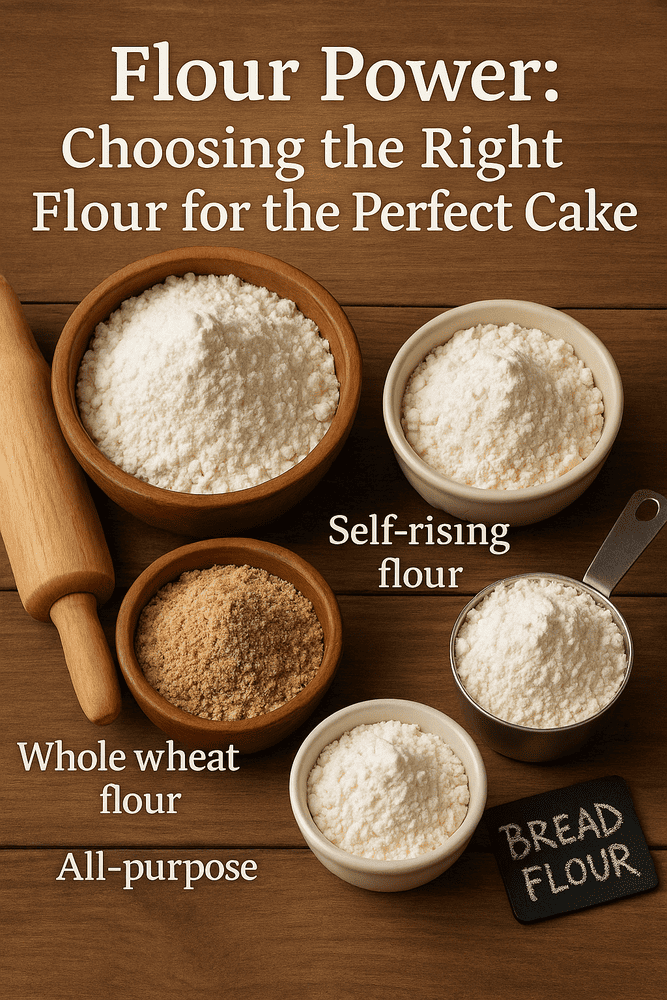Flour might seem like the most basic ingredient in cake baking, but it’s one of the most important and most misunderstood. Not all flours are the same, and the type you use can make the difference between a fluffy, tender cake and a dry, dense one. If you’ve ever wondered why your cake turned out chewy or collapsed in the middle, the answer could be in your flour choice.
In this article, we’ll break down the different types of flour used in cake baking, explain how gluten impacts cake texture, and help you understand how to choose and use the best flour for your recipes.
Let’s start with what flour is. Most cake flours are made from finely milled wheat. The primary component in flour is starch, but it also contains protein—mainly glutenin and gliadin. When mixed with liquid and agitated, these proteins form gluten, which provides structure to baked goods. However, too much gluten makes cakes tough. That’s why choosing the right protein content is key.
Cake flour has the lowest protein content, usually around 6–8%. This means it forms less gluten when mixed, resulting in a lighter, softer crumb. It’s also milled more finely than all-purpose flour, creating a silky texture and better absorption of liquids. If your goal is a delicate, bakery-style cake—like sponge cake or angel food—cake flour is ideal.
All-purpose flour, as the name suggests, is versatile and found in most kitchens. It contains 10–12% protein, which makes it suitable for a range of baked goods—from cookies to breads to cakes. However, it’s not perfect for all cakes. While it can produce great results in sturdier cakes like pound cake or carrot cake, it might make lighter cakes slightly tougher if overmixed.
Bread flour has the highest protein content, around 12–14%, and should be avoided for cake baking. It creates too much gluten, resulting in chewy, dense textures that are undesirable in most cakes.
Self-rising flour is another option often used in cakes. It’s essentially all-purpose flour with baking powder and salt already added. While convenient, it can limit your control over leavening. If a recipe doesn’t specifically call for it, it’s better to use plain flour and add your own leavening agents.
Whole wheat flour contains all parts of the wheat kernel, including the bran and germ. This makes it more nutritious but also heavier and coarser. Using 100% whole wheat flour in cakes is not recommended unless the recipe is designed for it. However, you can blend whole wheat with all-purpose or cake flour to add nutrition while maintaining softness.
There are also gluten-free flours like almond, coconut, or rice flour. These require different ratios and often need binders like xanthan gum. If you’re baking gluten-free, follow tested recipes or use a high-quality gluten-free flour blend labeled as suitable for cakes.
So, how do you substitute if you don’t have cake flour? A common trick is to remove 2 tablespoons of all-purpose flour per cup and replace it with 2 tablespoons of cornstarch. Sift the mixture well to aerate it. This reduces the protein content slightly and mimics the softness of cake flour.
When measuring flour, accuracy is everything. Too much flour results in a dry, dense cake. Always spoon flour into the measuring cup and level it off with a knife—never scoop directly with the cup, which packs in more flour than needed. For best results, weigh your flour using a kitchen scale.
Flour also affects how your cake rises and holds its shape. A higher protein content supports tall, structured cakes, while lower protein allows for delicate expansion. Knowing your recipe’s goals will help you match it to the right flour.
Let’s look at some cake types and the flour that works best:
- Sponge cakes, chiffon cakes, and angel food cakes: Cake flour is best for lightness and volume.
- Butter cakes and vanilla layer cakes: Cake flour or a cake flour substitute gives a tender crumb.
- Pound cakes or carrot cakes: All-purpose flour provides the structure needed for denser textures.
- Chocolate cakes: Often benefit from all-purpose flour due to the extra moisture from cocoa and liquids.
If your cake is collapsing, check whether your flour is too strong (too much gluten) or if you overmixed the batter. If it’s dry, too much flour could be the cause. Understanding how flour behaves gives you the ability to adjust and improve every bake.
Here are quick tips to get the best results from your flour:
- Use cake flour for soft, tender cakes
- Avoid bread flour in any cake recipe
- Substitute cake flour by mixing AP flour + cornstarch
- Weigh your flour for precision
- Sift your flour to incorporate air
- Mix gently to avoid over-developing gluten
Understanding flour is fundamental to cake baking success. It’s the foundation of your cake, quite literally, and the wrong choice can undo even the best recipe. By choosing the right flour and handling it correctly, you’ll gain consistency, softness, and superior results every time you bake.
If you’ve followed our previous guides on sugar, eggs, and cake structure, you now know how each component works together. Flour is what brings them all together—and with the right knowledge, you’re one step closer to mastering the perfect cake.
